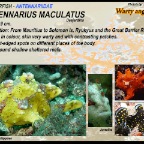Anglerfish - Antennariidae
ANGLERFISH - ANTENNARIIDAE
There are around forty different anglerfish species, also called "frogfish", living in tropical and subtropical waters. These odd looking fish have hand-like pelvic fins which they use to walk and to hold themselves between coral or sponges. In front of the first pectoral fin they developed a kind of antenna (illicium) with a bait-looking antenna (esca) at the end. The bait can resemble the shape of a worm or like thin filaments. They move this antenna up and down to attract prey and in one movement will eat them. Their prey can be the same size as the anglerfish itself. This action happens in less than six millionths of a second, making them champions in this kind of feeding. By opening the mouth far enough, the lower chin shoots outwards and creates an under-pressure in the mouth and gills. Even today not much is known about this muscular based kind of bio-mechanism. People who never heard about or seen anglerfish will swim over or pass without spotting them. Because they almost don't move and are able to change a bit of color, they blend so easily into their surrounding and turns them into masters of camouflage. It is mostly dive guides who show them to their guests because they know where the fish hang out. When anglerfish want to move to another place they suck the body full with water and squeeze it out the gill openings behind the pelvic fins and hoover to another spot. Length: 16 cm.Distribution: From E- Africa to Polynesia, S- Japan and Great Barrier Reef.Variable in colour, similar to A. maculatus but body with few if any warts. Has light-edged spots on different places of the body.Lives around shallow sheltered reefs from as shallow as - 0,5 m.The rod(illicium) is quite long. Length: 14 cm.Distribution: All tropical waters exept East Pacific.Yellow colour with a dark brown pattern. Covered with leafy and fleshy appendages, resembling floating seaweed which they use for their camouflage. Lives among floating Sargassum seaweed, this floating weed which travels with the currents is a habbitat for many young migrating fish and turtles. Length: 30 cm.Distribution: From the Red Sea to Panama, Japan and Society Islands.Variable in colour, from pale pink to black. Color change can happen from two days, up to several weeks. Often with warts and scab-like patches on the skin.On or next to sponges, in shallow lagoons or on seaward reefs, down to - 30 m. Extremely well camouflaged. Length: 13 cm.Distribution: Red Sea and E- Africa to SW- Japan, Australia and Central America.From pale pink to orange-red or brown-green, very short to no tailbase. Short lure (antenna). Dorsal fin goes all the way to tailfin. Freckles on the chin, belly and the sides of the body. Lives solitary, near reef crevices and coral rubble of coastal and outer reefs. Can be found to -104 m. Length: 22 cm.Distribution: From the Red Sea & S-Africa to Japan, Polynesia and New Zealand.Variable in colour, usually with zebra-like pattern over the entire body.The lure (illicium) which they use to attract small fish has a worm-like shape. The tassles on the body can be quite long, especially with species living in areas with filamentous algae. Usually found on sand or mud bottoms, from -10 to -218 m. Length: 9 cm.Distribution: From Mauritius to Solomon Is, Ryukyus and the Great Barrier Reef.Variable in colour, skin very warty and with contrasting patches. Has light-edged spots on different places of the body.Lives around shallow sheltered reefs. Length: 14 cm.Distribution: Red Sea & E- Africa to SW- Japan, New Guinea, Tahiti and Australia.Variable in colour, from grey to pale yellow, green, brown or black. Dark spot on each side of it’s back. Often has vertical dashed lines on tailfin. Solitary, intertidal areas of sheltered reefs, to maximum -10 m, but mostly seen not deeper than one meter. Mostly hidden behind or underneath corals.





















